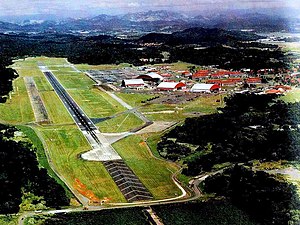Howard Air Force Base
This article includes a list of general references, but it lacks sufficient corresponding inline citations. (June 2014) |
| Howard Air Force Base | |
|---|---|
| Part of Air Combat Command | |
| Located near Balboa, Panama | |
 Howard Air Force Base, Canal Zone, about 1970 | |
| Coordinates | 8°54′54″N 79°35′58″W / 8.91500°N 79.59944°W |
| Type | Public |
| Site information | |
| Controlled by | United States Air Force |
| Site history | |
| Built | 1939 |
| In use | 1942-1999 |
Howard Air Force Base (
The airport is located 6 miles (9.7 km) southwest of Balboa, at the southern (Pacific) end of the Panama Canal. Most of the area around it was uninhabited and formed part of the Panama Canal Zone watershed, although Panama City could be reached by crossing the nearby Bridge of the Americas.
After demilitarization, the facility reopened as Panamá Pacífico International Airport in 2014.[1][2]
Overview
For over 50 years, Howard Air Force Base was the bastion of US air power in Central and South America. In its heyday, it was the center for counter-drug operations, military and humanitarian airlift, contingencies, joint-nation exercises, and search and rescue. It boasted fighters, cargo planes, tankers, airborne warning and control aircraft, operational support airlift "executive" jets, and search and rescue helicopters.
It was also home to a host of transient


Only a portion of the transports, several special-mission C-130s, two
History
Carved out of the jungle, 500 yards (460 m) from the Pacific Ocean, Howard Air Base opened in 1942. It was named after Major Charles H. Howard (1892–1936), who flew in Panama in the late 1920s.
The only five-star general in Air Force history, Henry H. "Hap" Arnold played a prominent role in the history of Howard AFB and military aviation in Panama. As a captain, Arnold led the first air unit, the
Construction began shortly thereafter and the first troops arrived on May 15, 1941. Howard Field hosted both fighter and bomber aircraft during the World War II era. The base was inactivated on January 1, 1950, and its real estate turned over to the Army.
The Air Force continued to use Howard as a deployment site for joint training exercises during the 1950s, and by December 1961 all USAF flying operations in Panama relocated to Howard. On October 1, 1963, the Air Force officially reclaimed Howard from the Army and the base played a central role in US military operations in Latin America ever since, largely due to its 8,500-foot (2,600 m) runway and its status as the only jet-capable US air field south of the Rio Grande.
Control of the Panama Canal changed hands on 31 December 1999, from the United States to Panama.
Previous names
- Bruja Point Military Reservation, 11 August 1928
- Fort Bruja, 1929
- William A. Kobbe, USA, who died 1 November 1931) 1932; airfield section of Fort Kobbe named Howard Field, 1 December 1939
- Howard Air Base, 10 July 1941
- Howard Air Force Base, 1948 – February 1950; October 1955 – 1999
Major commands to which assigned
- Panama Canal Department, 1 December 1939 – 19 October 1940
- Panama Canal Air Force, 19 October 1940 – 5 August 1941
- Caribbean Air Force, 5 August 1941 – 18 September 1942
- Sixth Air Force, 18 September 1942 – 31 July 1946
- Caribbean Air Command, 31 July 1946 – 8 July 1963
- Operations at Howard drew down during the summer of 1949 and all training ceased on 11 October 1949; the base was transferred in inactive status to United States Army Caribbean, and Caribbean Air Comd, USAF, agreement (18 August 1955) permitted the resumption of regular flying operations at Howard in October 1955.
- United States Air Forces Southern Command, 8 July 1963 – 1 January 1976
- Tactical Air Command
- USAF Southern Air Division, 1 January 1976 – 1 January 1989
- 830th Air Division, 1 January 1989 – 15 February 1991
- Air Forces Panama, 15 February 1991 – 11 February 1992
- Tactical Air Command, 11 February – 31 May 1992
- Air Combat Command, 31 May 1992 – 1 November 1999
Major units assigned
|
|
Education
The
See also
- List of former United States military installations in Panama
- List of United States Air Force installations
Notes
- ^ Hilarski, Randy (April 9, 2013). "Howard Air Force Base has Been Transformed into Panama Pacifico". Panama Simple. Archived from the original on April 15, 2015. Retrieved 2015-04-08.
- ^ "VivaColombia confirms Panama and Peru services and new base at Bogota in 2014". CAPA Center for Aviation. 2013-12-20. Retrieved 2015-04-08.
Bogota-Panama City service
- ^ I was the detachment commander there
- ^ "Americas.html". Department of Defense Education Activity. 1998-12-06. Archived from the original on 1998-12-06. Retrieved 2022-07-11. - Detail of Panama schools
References
- Maurer, Maurer (1983). Air Force Combat Units Of World War II. Maxwell AFB, Alabama: Office of Air Force History. ISBN 0-89201-092-4.
- Maurer, Maurer, ed. (1982) [1969]. Combat Squadrons of the Air Force, World War II (PDF) (reprint ed.). Washington, DC: Office of Air Force History. OCLC 72556.
- Fletcher, Harry R. (1989) Air Force Bases Volume II, Active Air Force Bases outside the United States of America on 17 September 1982. Maxwell AFB, Alabama: Office of Air Force History. ISBN 0-912799-53-6
![]() This article incorporates public domain material from the Air Force Historical Research Agency
This article incorporates public domain material from the Air Force Historical Research Agency
External links
- Accident history for BLB at Aviation Safety Network




